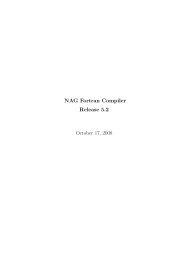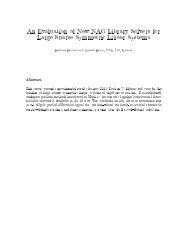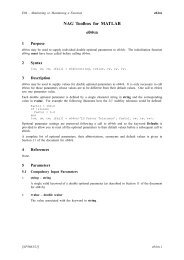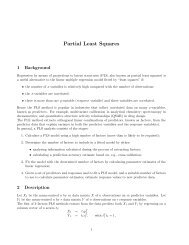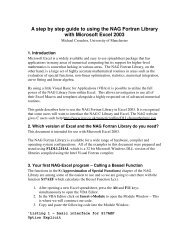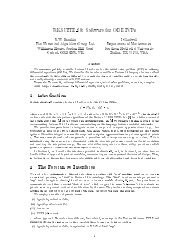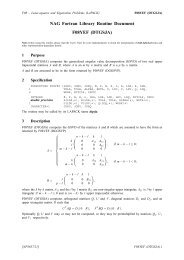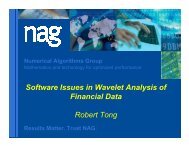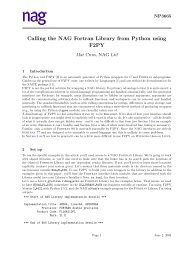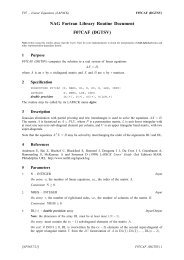NAG Fortran Library Routine Document G05EHF
NAG Fortran Library Routine Document G05EHF
NAG Fortran Library Routine Document G05EHF
You also want an ePaper? Increase the reach of your titles
YUMPU automatically turns print PDFs into web optimized ePapers that Google loves.
G05 – Random Number Generators<br />
<strong>G05EHF</strong><br />
<strong>NAG</strong> <strong>Fortran</strong> <strong>Library</strong> <strong>Routine</strong> <strong>Document</strong><br />
<strong>G05EHF</strong><br />
Note: before using this routine, please read the Users’ Note for your implementation to check the interpretation of bold italicised terms and<br />
other implementation-dependent details.<br />
1 Purpose<br />
<strong>G05EHF</strong> performs a pseudo-random permutation of a vector of integers.<br />
2 Specification<br />
SUBROUTINE <strong>G05EHF</strong>(INDEX, N, IFAIL)<br />
INTEGER INDEX(N), N, IFAIL<br />
3 Description<br />
The routine permutes the elements of INDEX without inspecting their values. Each of the n! possible<br />
permutations of the n values may be regarded as being equally probable.<br />
Even for modest values of n (greater than 25 say), it is theoretically impossible that all n! permutations<br />
may occur, as n! exceeds the cycle length of G05CAF. For practical purposes this is irrelevant, as the time<br />
necessary to generate all possible permutations is many millenia.<br />
4 References<br />
Knuth D E (1981) The Art of Computer Programming (Volume 2) (2nd Edition) Addison-Wesley<br />
Kendall M G and Stuart A (1969) The Advanced Theory of Statistics (Volume 1) (3rd Edition) Griffin<br />
5 Parameters<br />
1: INDEX(N) – INTEGER array Input/Output<br />
On entry: the n integer values to be permuted.<br />
On exit: the n permuted integer values.<br />
2: N – INTEGER Input<br />
On entry: the number of values to be permuted.<br />
Constraint: N 1.<br />
3: IFAIL – INTEGER Input/Output<br />
On entry: IFAIL must be set to 0, 1 or 1. Users who are unfamiliar with this parameter should<br />
refer to Chapter P01 for details.<br />
On exit: IFAIL ¼ 0 unless the routine detects an error (see Section 6).<br />
For environments where it might be inappropriate to halt program execution when an error is<br />
detected, the value 1 or 1 is recommended. If the output of error messages is undesirable, then the<br />
value 1 is recommended. Otherwise, for users not familiar with this parameter the recommended<br />
value is 0. When the value 1 or 1 is used it is essential to test the value of IFAIL on exit.<br />
[NP3546/20A]<br />
<strong>G05EHF</strong>.1
<strong>G05EHF</strong><br />
<strong>NAG</strong> <strong>Fortran</strong> <strong>Library</strong> Manual<br />
6 Error Indicators and Warnings<br />
If on entry IFAIL ¼ 0or 1, explanatory error messages are output on the current error message unit (as<br />
defined by X04AAF).<br />
Errors or warnings detected by the routine:<br />
IFAIL ¼ 1<br />
On entry, N < 1.<br />
7 Accuracy<br />
Not applicable.<br />
8 Further Comments<br />
The time taken by the routine is of order n.<br />
In order to permute other kinds of vectors, or matrices of higher dimension, the following technique may<br />
be used:<br />
(a) Set INDEXðiÞ ¼i, for i ¼ 1; 2; ...;n<br />
(b) Use <strong>G05EHF</strong> to permute INDEX<br />
(c) Use the contents of INDEX as a set of indices to access the relevant vector or matrix.<br />
In order to divide pseudo-randomly a vector or matrix into subgroups of chosen sizes, a similar procedure<br />
may be used. INDEX is first set to the number of 1s, 2s, etc., corresponding to the size of each group,<br />
then permuted, and used to index the groups.<br />
9 Example<br />
A vector containing the first eight positive integers in ascending order is permuted and the permutation is<br />
printed. This is repeated a total of ten times.<br />
The generator mechanism used is selected by an initial call to G05ZAF.<br />
9.1 Program Text<br />
Note: the listing of the example program presented below uses bold italicised terms to denote precision-dependent details. Please read the<br />
Users’ Note for your implementation to check the interpretation of these terms. As explained in the Essential Introduction to this manual,<br />
the results produced may not be identical for all implementations.<br />
* <strong>G05EHF</strong> Example Program Text<br />
* Mark 20 Revised. <strong>NAG</strong> Copyright 2001.<br />
* .. Parameters ..<br />
INTEGER<br />
N<br />
PARAMETER<br />
(N=8)<br />
INTEGER<br />
NOUT<br />
PARAMETER<br />
(NOUT=6)<br />
* .. Local Scalars ..<br />
INTEGER I, IFAIL, J, K, M<br />
* .. Local Arrays ..<br />
INTEGER<br />
INDEX(N)<br />
* .. External Subroutines ..<br />
EXTERNAL G05CBF, <strong>G05EHF</strong>, G05ZAF<br />
* .. Executable Statements ..<br />
CALL G05ZAF(’O’)<br />
WRITE (NOUT,*) ’<strong>G05EHF</strong> Example Program Results’<br />
WRITE (NOUT,*)<br />
M = 10<br />
CALL G05CBF(0)<br />
WRITE (NOUT,99998) M, ’ Permutations of first ’, N, ’ integers’<br />
WRITE (NOUT,*)<br />
DO 40 J = 1, M<br />
<strong>G05EHF</strong>.2<br />
[NP3546/20A]
G05 – Random Number Generators<br />
<strong>G05EHF</strong><br />
DO 20 I = 1, N<br />
INDEX(I) = I<br />
20 CONTINUE<br />
IFAIL = 0<br />
*<br />
CALL <strong>G05EHF</strong>(INDEX,N,IFAIL)<br />
*<br />
WRITE (NOUT,99999) (INDEX(K),K=1,N)<br />
40 CONTINUE<br />
STOP<br />
*<br />
99999 FORMAT (1X,8I3)<br />
99998 FORMAT (1X,I2,A,I1,A)<br />
END<br />
9.2 Program Data<br />
None.<br />
9.3 Program Results<br />
<strong>G05EHF</strong> Example Program Results<br />
10 Permutations of first 8 integers<br />
7 8 1 2 4 6 3 5<br />
3 1 4 6 7 8 5 2<br />
7 6 5 1 3 4 8 2<br />
6 2 7 3 8 5 1 4<br />
1 6 2 4 7 8 5 3<br />
4 1 5 8 7 6 3 2<br />
8 3 1 6 4 2 5 7<br />
1 2 6 7 8 4 3 5<br />
2 5 7 6 3 1 4 8<br />
2 8 6 7 3 5 1 4<br />
[NP3546/20A]<br />
<strong>G05EHF</strong>.3 (last)



